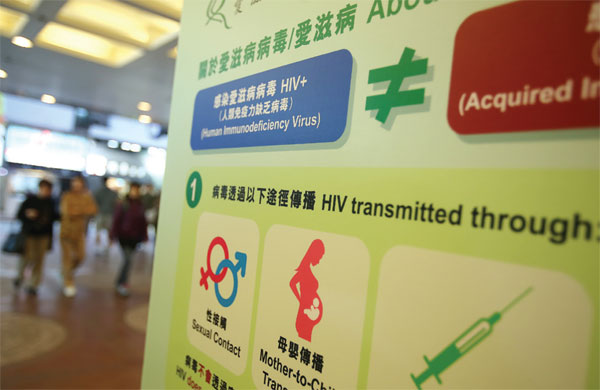Crystal meth fueling big rise in HIV cases
Updated: 2016-02-24 07:54
By Timothy ChuI and Shadow Li in Hong Kong(HK Edition)
|
|||||||||
|
The Society for AIDS Care displays advertisements at Times Square on Tuesday to raise public awareness on HIV/AIDS. Parker Zheng / China Daily |
The growing abuse of methamphetamine in Hong Kong is also helping to fuel a sharp increase in HIV cases.
Hong Kong now feels a lot like Los Angeles during the crystal methamphetamine craze of the 1990s. Drugs and alcohol counselor Paul Schulte attributes the HIV rate's rise in the city to a largely unnoticed increase in methamphetamine abuse.
Rational thinking is giving way to people making terrible decisions. It is also leading to increased risk-taking behavior while under the influence of these drugs.
Schulte said he had noticed a similar trend in Singapore.
Crystal meth has become associated with grimy addicts thanks to popular television series Breaking Bad, but users in Asia's financial centers are not restricted to a single socio-economic group. There are a considerable number of users working in white collar jobs. Some of them have also attended the most prestigious universities in the West.
The proportion of Hong Kong's drug abusers taking "ice" has gradually increased from 15.2 percent in 2012 to 18.3 percent in 2013, rising further to 23 percent in 2014. The number of reported meth abusers rose steadily from 1,683 in 2012 to 1,858 in 2013, then to 2,025 in 2014, according to the Security Bureau.
Methamphetamine has surpassed ketamine as the most common type of psychotropic substance abused, according to the bureau.
At the same time, near annual record-breaking shipments of ice passing through Hong Kong have been detected.
Schulte has witnessed what he says is an astonishing increase in methamphetamine abuse by both local residents and foreigners in the homosexual community. He said meth had been supplanting relatively diluted cocaine sold on the city's streets. It was sought after for its 12-hour highs, he explained.
This trend is no surprise given South China's leadership in meth and meth precursor production and shipping.
The drug's promotion of unsafe behavior came in two forms, firstly through more incidents of unsafe sex and secondly through infected needles, since injecting meth unleashed its greatest high, Schulte said.
Curbing meth addiction would bring about immediate impacts on HIV infection rates, he said. But Hong Kong's response to addicts had to be more compassionate. There needed to be alternatives to criminal charges for first-time and repeat offenders. This could include mandatory rehab and other treatment options as well as incentive programs for users. This could help them to keep clean while they were recovering, added Schulte.
More assistance at hospital accident and emergency rooms would help those coming round from harsh drug comedowns, he suggested.
The growth in reported HIV rates is especially pronounced among the homosexual and bisexual community, with 434 new cases seen last year compared with 135 cases through heterosexual contact.
Schulte believed the number of actual cases was much higher - by some 40 percent - according to experience overseas.
Psychiatric specialist Vanessa Wong Ting-chi expects 2016 to be another record-setting year. She noted that higher infection rates were self-perpetuating as the number of possible transmitters increased.
Government figures also show the ages of those infected have lowered, with people in their 20s accounting for 30 percent of new cases.
Wong advocates greater education among students to combat the trend. She added that social media and mobile apps had helped facilitate potential partners for drugs and sex.
Contact the writers through tim@chinadailyhk.com
(HK Edition 02/24/2016 page8)
